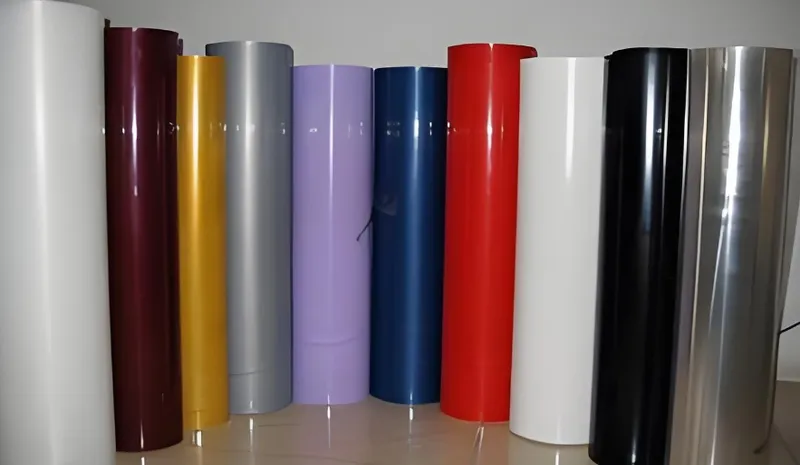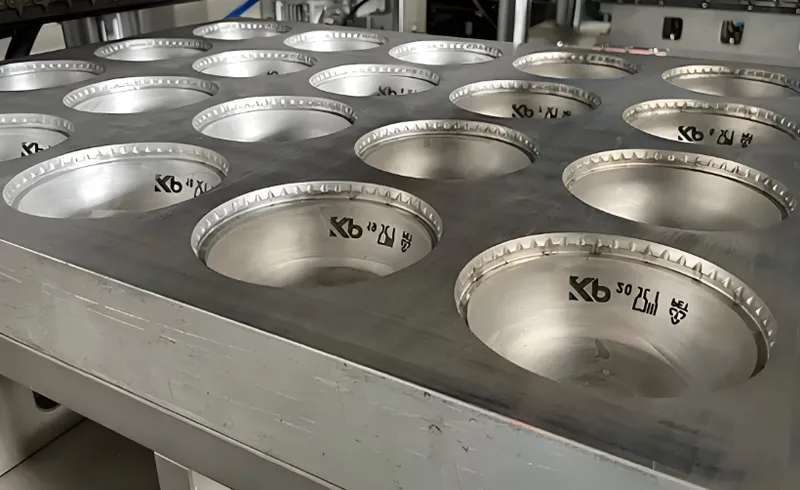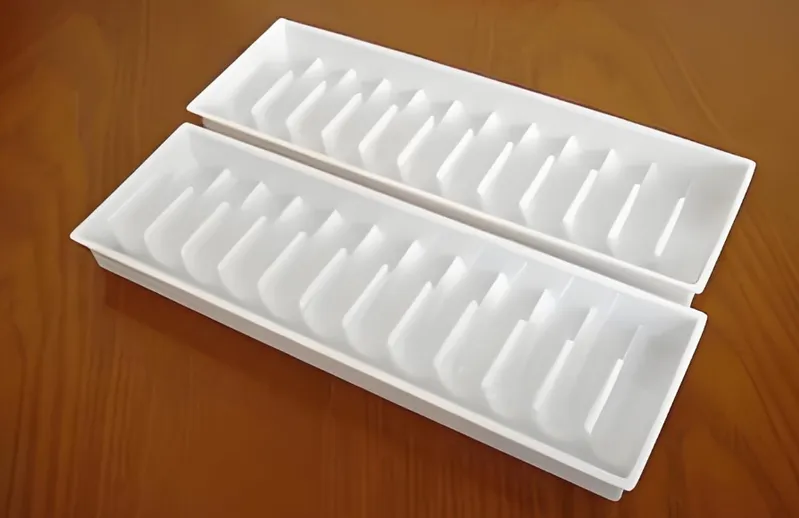
Thermoforming is a versatile manufacturing process that transforms plastic sheets into a wide array of products, from packaging to automotive components. By heating a plastic sheet until it's pliable and then forming it over a mold using vacuum, pressure, or mechanical force, thermoforming offers a kostengünstige Lösung1 for producing lightweight, durable items. Its applications span industries like packaging, automotive, medical, and consumer goods, making it a go-to method for both prototyping and mass production.
Thermoformen heizt plastic sheets2 to shape them into products like packaging or car parts, using materials like ABS, PVC, and PET for cost-effective, versatile manufacturing across industries.
Understanding the materials and process intricacies is key to leveraging Thermoformung3’s benefits for your industry. Delve deeper to explore how different materials and techniques affect the final product’s properties and applications.
Tiefziehen ist nur für einfache Formen geeignet.Falsch
Thermoforming can handle complex designs, including undercuts and intricate details, especially with advanced techniques like pressure forming.
ABS ist das am häufigsten verwendete Material für die Thermoformung.Wahr
ABS is favored for its strength, durability, and ease of processing, making it a popular choice across various industries.
- 1. Welche Materialien werden üblicherweise beim Thermoformen verwendet?
- 2. Was sind die einzelnen Schritte des Thermoformverfahrens?
- 3. What Factors Affect the Thermoforming Process?
- 4. Was sind die Anwendungen des Thermoformens?
- 5. Wie ist das Thermoformen im Vergleich zu anderen Verfahren?
- 6. Schlussfolgerung
Welche Materialien werden üblicherweise beim Thermoformen verwendet?
Thermoforming materials are pivotal in industries needing lightweight, durable, and cost-effective products, enhancing efficiency and reducing costs.

Common thermoforming materials include ABS, PVC, PET, polypropylene, and polycarbonate, each offering unique properties like strength, clarity, or chemical resistance for specific applications.
| Material Typ | Eigenschaften | Anwendungen |
|---|---|---|
| ABS | Stark, langlebig, stoßfest | Automobilteile, Gehäuse |
| PVC | Clear, protective, cost-effective | Blister packs, medical trays |
| PET | Food-safe, strong, recyclable | Food packaging, bottles |
| Polypropylen (PP) | Chemical/heat-resistant, flexible | Automotive, household items |
| Polycarbonat (PC) | Tough, transparent, heat-resistant | Safety gear, lenses, medical devices |
Acrylnitril-Butadien-Styrol (ABS)
ABS is a widely used thermoplastic in thermoforming due to its excellent balance of strength, rigidity, and impact resistance. It is commonly used in automotive parts like dashboards and interior panels, as well as in consumer goods such as appliance housings and toys. Its ability to be easily colored and finished makes it a versatile choice for aesthetic applications.
Polyvinylchlorid (PVC)
PVC is valued for its clarity and protective qualities, making it ideal for packaging applications like blister packs and clamshells. It is also used in medical trays due to its sterilizability and cost-effectiveness. PVC can be formulated to be rigid or flexible, depending on the application.

Polyethylenterephthalat (PET)
PET is a food-safe, strong, and recyclable material commonly used in food packaging, such as trays and bottles. Its clarity and barrier properties make it suitable for products requiring visibility and protection from external elements.
Polypropylen (PP)
PP is known for its chemical and heat resistance, making it suitable for automotive components and household items like containers and lids. Its flexibility and durability also make it a popular choice for products that require hinge-like movements.

Polycarbonat (PC)
PC is a tough, transparent material with high heat resistance, used in applications requiring durability and clarity, such as safety equipment, lenses, and medical devices. Its impact resistance makes it ideal for products that need to withstand harsh conditions.
ABS is a key material used in thermoforming.Wahr
ABS is commonly used due to its excellent balance of strength, rigidity, and impact resistance, suitable for automotive and consumer goods.
Thermoforming materials are unsuitable for all industries despite their benefits.Wahr
While they offer various advantages, some industries may require materials with different properties, such as extreme heat resistance or specific chemical compatibilities.
Was sind die einzelnen Schritte des Thermoformverfahrens?
The thermoforming process is pivotal in producing lightweight, durable products across industries by heating and shaping plastic sheets.
The thermoforming process involves heating a plastic sheet, forming it over a mold using vacuum, pressure, or mechanical force, cooling, and trimming to create the final product.

Heizung
The plastic sheet is heated to a pliable temperature using radiant heaters or convection ovens. The temperature must be carefully controlled to ensure the material is soft enough to form but not so hot that it degrades.
Bildung von
The heated sheet is then stretched over or into a mold using one of the following methods:
-
Vakuumverformung: A vacuum pulls the sheet onto the mold.
-
Druckumformung: Compressed air pushes the sheet into the mold for more intricate details.
-
Mechanische Umformung: Physical force is used to shape the sheet.

Kühlung
The formed part is cooled, often using air or water, to set its shape. Proper cooling is essential to prevent warping or deformation.
Beschneiden und Endbearbeitung
Excess material is trimmed away, and secondary operations such as painting, silk screening, or assembly may be performed to complete the product.
Thermoforming always results in uniform thickness.Falsch
The thickness can vary depending on the design and process parameters, such as the depth of the draw or the type of mold used.
Thermoforming reduces material waste compared to other processes.Wahr
By using sheets and trimming excess, thermoforming can be more material-efficient than processes like injection molding.
What Factors Affect the Thermoforming Process?
Die Tiefziehverfahren4 is critical in creating high-quality products, and several factors influence its success.
Key factors in thermoforming include temperature, vacuum/pressure levels, Formgestaltung5und material thickness6, which determine the final product's quality and performance.

Temperatur
The heating temperature must be precisely controlled for each material. For example, ABS typically requires temperatures between 220–260°F, while PVC needs 250–300°F. Incorrect temperatures can lead to poor forming or material degradation.
Vacuum/Pressure Levels
The level of vacuum or pressure affects the detail and precision of the formed part. Higher pressure can achieve more intricate designs but may require stronger molds and more robust equipment.
Formenbau
Mold design is crucial, with considerations for draft angles (1–2° for easy release), corner radii (minimum 0.030 inches to prevent thinning), and undercuts (which may require special mold features).

Material Thickness
The thickness of the plastic sheet impacts the strength and formability of the final product. Thin-gauge sheets (<0.060 inches) are used for packaging, while heavy-gauge sheets (>0.120 inches) are for structural parts.
Material selection is vital for determining the final product's characteristics.Wahr
Different materials offer unique properties like strength, clarity, or chemical resistance, directly influencing the product's performance.
All thermoforming processes use the same mold design.Falsch
Mold designs vary based on the complexity of the part, the material used, and the forming technique employed.
Was sind die Anwendungen des Thermoformens?
Thermoforming offers versatile solutions in manufacturing, contributing to lightweight and cost-effective products across several sectors.
Thermoforming is used in packaging, automotive, medical, and consumer goods for products like trays, interior panels, and appliance housings, enhancing efficiency and reducing costs.

Verpackung
Thermoforming is widely used in Verpackung7 for products like blister packs, clamshells, and trays due to its ability to create custom shapes quickly and cost-effectively.
Automobilindustrie
In der Automobil8 industry, thermoforming produces interior components such as dashboards, door panels, and trim, valued for their lightweight and durable properties.

Medizinische
Medical applications include sterile trays, containers, and device components, often requiring materials like PET for clarity and safety.
Konsumgüter
Thermoforming is used to create aesthetic and functional items like appliance housings, toys, and furniture, leveraging materials like ABS and polycarbonate.
Thermoforming reduces production costs in manufacturing.Wahr
By using less expensive tooling and faster production cycles, thermoforming can lower overall manufacturing costs.
Das Thermoformen wird nur in der Verpackungsindustrie verwendet.Falsch
Thermoforming is utilized in various sectors, including automotive, medical, and consumer goods, for a wide range of applications.
Wie ist das Thermoformen im Vergleich zu anderen Verfahren?
Thermoforming stands out for its balance of cost, speed, and versatility, but it's essential to understand how it compares to other manufacturing processes.

Thermoforming offers lower tooling costs and faster turnaround9 than injection molding but may lack precision for highly complex parts; it's ideal for low to medium production volumes10.
| Prozess | Werkzeugkosten | Produktionsgeschwindigkeit | Handhabung der Komplexität | Am besten für |
|---|---|---|---|---|
| Tiefziehen | Niedrig | Schnell | Mäßig | Low to medium volumes, custom shapes |
| Spritzgießen | Hoch | Mäßig | Hoch | Hohe Stückzahlen, präzise Teile |
| Blasformen | Mäßig | Mäßig | Niedrig | Hollow containers |
| Rotationsgießen | Mäßig | Langsam | Niedrig | Large, hollow items |
Thermoformung vs. Spritzgießen
Thermoforming has geringere Werkzeugkosten11 (about 1/5 for large parts) and faster development times (8–10 weeks) compared to injection molding, making it ideal for low to medium production runs. However, injection molding offers higher precision for complex parts.

Thermoformen vs. Blasformen
Thermoforming is better suited for non-hollow parts, while blow molding is designed for hollow items like bottles and containers.
Thermoformen vs. Rotationsgießen
Thermoforming provides faster production cycles and more detailed parts, whereas rotational molding is used for large, hollow, single-piece items like tanks and playground equipment.
Thermoforming is always the best choice for plastic manufacturing.Falsch
While versatile, thermoforming may not be suitable for high-volume production or parts requiring extreme precision.
Thermoforming offers faster turnaround times than injection molding.Wahr
With simpler tooling and quicker setup, thermoforming can bring products to market faster than injection molding.
Schlussfolgerung
Thermoforming stands out for its balance of cost, speed, and versatility, making it ideal for a wide range of applications. By understanding the materials and process intricacies, manufacturers can optimize their production for better quality and efficiency. For those looking to delve deeper, resources like Formlabs' Guide to Thermoforming offer comprehensive insights.
-
Learn about the advantages of cost-effective solutions in manufacturing, including efficiency and sustainability, to enhance your production strategies. ↩
-
Discover the different types of plastic sheets used in thermoforming and how they impact the manufacturing process and product quality. ↩
-
Explore this link to gain a comprehensive understanding of thermoforming, its processes, and its diverse applications in various industries. ↩
-
Understanding the thermoforming process is essential for anyone involved in manufacturing, as it directly impacts product quality and efficiency. ↩
-
Exploring mold design can provide insights into optimizing production and achieving high-quality results in thermoforming. ↩
-
Learning about material thickness is crucial for selecting the right materials and ensuring the durability of the final product. ↩
-
Discover how thermoforming enhances packaging efficiency and customization, making it a preferred choice for many products. ↩
-
Learn about the significance of thermoforming in producing lightweight and durable automotive components, crucial for modern vehicles. ↩
-
Exploring faster turnaround benefits can reveal strategies to enhance production timelines and customer satisfaction. ↩
-
Learning about low to medium production volumes can guide companies in choosing the right manufacturing process for their needs. ↩
-
Understanding lower tooling costs can help businesses optimize their manufacturing budget and improve efficiency. ↩








